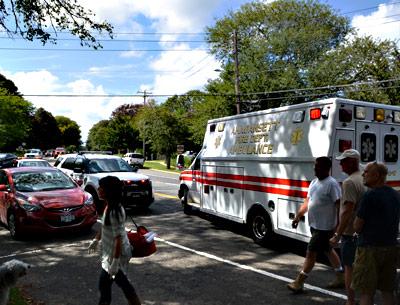Amagansett Opts for Paid E.M.T.

The Amagansett Fire District will follow the lead of Montauk’s district by hiring a paid advanced life support provider to assist in responding to ambulance calls.
At its annual meeting on Oct. 15, the hamlet’s board of fire commissioners voted to include $103,000, earmarked for paid advanced life support personnel, in its proposed 2014 budget. The fire commissioners will hold a public meeting tonight at 7 at the firehouse to discuss details of the plan.
Total appropriations in the Amagansett district’s proposed budget are $1.45 million. Less $365,000 in estimated revenues, $1.085 million would be raised for the district’s operations through property taxes.
The Amagansett district’s plan comes amid increasing demand, particularly in the summer months, and a stagnant or dwindling pool from which to draw volunteers. According to its Web site, the Amagansett Fire Department had logged 337 emergency medical service incidents through July. From 2007 through 2012, it responded to an average of 556 such incidents per year. The department recently erected signs outside the firehouse and on Main Street appealing for volunteers.
“We’re down to one E.M.T. in the district,” said Daniel Shields II, chairman of the Amagansett Board of Fire Commissioners, referring to Tom Field, a volunteer and the district’s sole A.L.S. provider. “To protect the community, we felt it was in our best interest to go this route. We’re running out of people. . . . We need somebody that’s going to be around year round.”
“We’ve got to be partially paid, and at some point we’ve got to be fully paid,” Mr. Field said on Tuesday. “The rationale is that we do not have people available in the daytime — it’s as simple as that, and has been for quite a number of years.” He started agitating for membership drives at least 15 years ago, he said, after realizing that “it’s just by accident that we’re getting by. The frustration to me was that we weren’t getting new members in.”
Another frustration, Mr. Field said, is the burden one overextended district inflicts on the others. “So what happened in Montauk was a godsend,” he said.
In the Amagansett district, the plan for a paid A.L.S. technician calls for a full-time schedule in the summer months and part time in the off-season, Mr. Shields said, similar to the Montauk district’s pilot program enacted last summer. That program is widely viewed as a success. “We’re going to try to do what Montauk is doing,” Mr. Shields said, “and go from there.”
Since early this year, East Hampton Town departments have been exploring the addition of paid emergency medical technicians, both to accommodate demand and reduce the need for mutual aid assistance calls, under which emergency units from outside fire districts are required to respond.
Such a townwide program is not imminent, said Barbara Borsack, the deputy mayor of East Hampton Village. “I don’t know how long it’s going to take,” Ms. Borsack, a longtime emergency medical volunteer who serves on an informal committee exploring the addition of paid positions, said. “At this point, that’s why [districts] are going out on their own, because we have to start planning for next summer.”
Ms. Borsack predicted that all districts would “move toward some level of paid service, just because we have no choice. There’s a limit to what the volunteers can do.”
While demand surges in the summer, year-round residents find it difficult to commit to volunteer service, Ms. Borsack said. “It’s the cost of living here that’s the problem,” she said. “We have fewer and fewer kids staying in town, and younger people having to work two and three jobs to live here. The calls keep going up and your supply [of volunteers] doesn’t — you have pretty much the same number of year-round people living here.”
